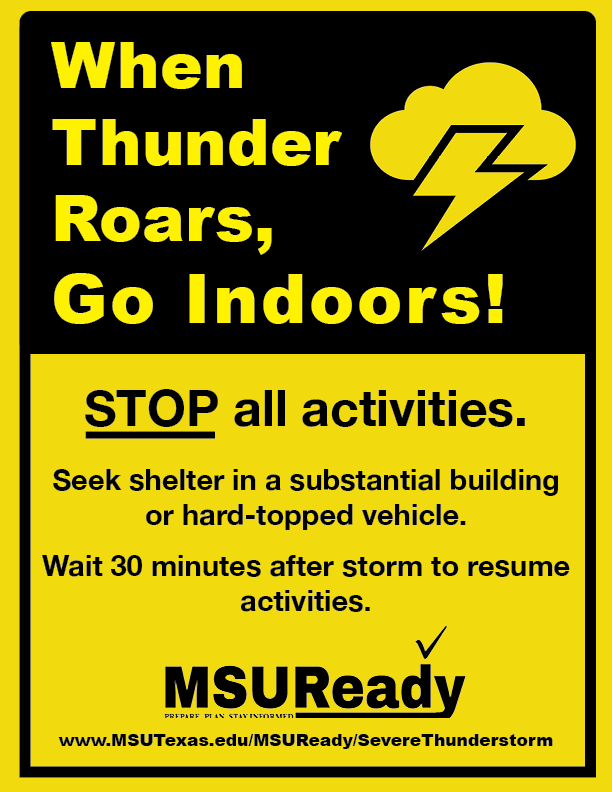| Facts About Severe Thunderstorms | |
 |
 |
| Hail 1" In diameter or larger | Can happen anytime |
 |
 |
| Winds up to 58 MPH (93 Kph) or higher | Can happen anywhere |
Severe Thunderstorm Watch: Be Prepared! Severe thunderstorms are possible in and near the watch area. Stay informed and be ready to act if a severe thunderstorm warning is issued. The watch area is typically large, covering numerous counties or even states.
Severe Thunderstorm Warning: Take Action! Severe weather has been reported by spotters or indicated on weather radar. Warnings indicate imminent danger to life and property. Warnings typically encompass a much smaller area (around the size of a city or small county) that may be impacted by large hail or damaging wind identified by an NWS forecaster on radar or by a trained spotter.
- Before a Severe Thunderstorm
- During a Severe Thunderstorm
- After a Severe Thunderstorm
Be Weather-Ready: Check the forecast regularly to see if you're at risk for severe weather. Listen to local news or check the Norman National Weather Service webpage to stay informed about severe thunderstorm watches and warnings.
Sign up for MSUAlerts: The number one way to receive an emergency alert from MSU Texas is through an MSU Alert. Visit MSU ALERT for more information on how to sign up and keep your information up to date.
Download MSU Safety App: Safety starts with you! Download the MSU Safety app available on the Apple app store and the Google play store. The app lets you have access to critical information right in your hand when it matters most.
Know What to Do: When a Severe Thunderstorm Warning is issued know what to do and where to go in your building.
Build or Re-Stock Your Kit: Have critical items to help you survive before help arrives. During large-scale disasters, help could be delayed.
A warning is issued when severe weather conditions are happening now or will happen in the next 45 Minutes.
Stay Weather-Ready: Continue to listen to local news or check the Norman National Weather Service Webpage to stay updated about severe thunderstorm watches and warnings.
In the Dorm: Go to a secure area in your room if you receive an MSUAlert or Severe Thunderstorm Warning. Damaging wind or large hail may be approaching.
Around the University: Stay away from windows as wind debris and large hail can shatter windows and cause injuries. Do not go to large open areas such as cafeterias, gymnasiums, or auditoriums.
Outside: Go inside a sturdy building immediately if a severe thunderstorm is approaching. Sheds and storage facilities are not safe. Taking shelter under a tree can be deadly. The tree may fall on you. Standing under a tree can also put you at a greater risk of getting struck by lightning.
In a Vehicle: Being in a vehicle during a severe thunderstorm is safer than being outside; however, drive to the closest secure shelter if there is sufficient time.
Stay informed: Continue checking weather conditions to stay updated about severe thunderstorm watches and warnings. More severe thunderstorms could be heading your way.
Contact Your Family and Loved Ones: Let your family and close friends know that you're okay so they can help spread the word. Text messages or social media are more reliable forms of communication than a phone call
Assess the Damage: After you are sure the severe weather threat has ended, check your personal possessions/property for damages (Ex. car, etc.) Contact MSUPD if you see power lines down or any other safety threats. Stay out of damaged buildings!
Help your fellow Mustangs: If you come across people that are injured and you are properly trained, if needed, provide first aid to victims until help arrives.
Get inside as soon as you hear thunder. Go to a substantial building or hard-topped metal vehicle as fast as you can. Stay inside a safe building or vehicle for at least 30 min after you hear the last thunder. While 30 minutes may seem like a long time, it is necessary to be safe. If you can't get to a safe building or vehicle:
- Avoid open areas. Don't be the tallest object in the area.
- Stay away from isolated tall trees, towers, or utility poles. Lightning tends to strike the taller objects in an area.
- Stay away from metal conductors such as wires or fences. Metal does not attract lightning, but lightning can long-distance through it.
Cardiac arrest is the immediate cause of death. Lightning victims do not carry an electrical charge and may need first aid immediately.
- Call 9-1-1 for help.
- Give first aid. Begin CPR if you are trained.
- Use an Automatic External Defibrillator (AED) if one is available. This is a life-saving device.
- Don't be a victim. If possible, move the victim to a safer place. Lightning CAN strike twice.
Each year in the US, there are about 25 million cloud-to-ground lightning flashes and about 300 people struck by lighting. Of those struck, about 30 people are killed and others suffer lifelong disabilities. Most of these tragedies can be prevented. Some people were struck because they went back outside too soon.
- All thunderstorms produce lightning and are dangerous. Fortunately, people can be safe if they follow some simple guidelines when thunderstorms are forecast.
- Lightning often strikes outside the area of heavy rain and may strike as far as 10 miles from any rainfall. Many lightning deaths occur ahead of storms before any rain arrives or after storms have seemingly passed and the rain has ended.
- If you can hear thunder, you are in danger. Don’t be fooled by blue skies. If you hear thunder, lightning is close enough to pose an immediate threat.

